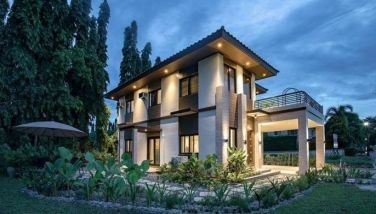Rice husk ash good cement substitute
August 9, 2003 | 12:00am
LOS BAÑOS, Laguna – Ash from rice husk is an effective substitute for cement.
Also, it can be used as additive to reduce corrosion and increase durability of concrete structures.
These were found in studies done by researchers of Angeles University Foundation-College of Engineering (AUF-CE) in Angeles City (Pampanga).
The technology is now being transferred initially in Central Luzon owing to its being the rice granary of the country.
Spearheading the technology transfer campaign are AUF (as the implementing agency) and the Department of Science and Technology-Philippine Council for Industry and Energy Research and Development (DOST-PCIERD, as funding agency).
Under the agreement, the rice husk will be supplied by the V. del Rosario Ricemill in San Leonardo, Nueva Ecija.
Central Luzon’s annual rice husk production during the 1990-99 period exceeded 350,000 metric tons, according to statistics compiled by the Biomass Atlas of the Philippines.
"Because rice husk is considered a waste by-product in the scope of milling operations in the Philippines, this innovation is projected to boost the efficiency of agricultural practices not only in Region 3 but also throughout the country," DOST stated.
DOST explained that when rice husk is burned, 17 to 25 percent of its weight is retained in ash form.
The rice husk ash (RHA) can be used as a pozzolana to replace ordinary portland cement up to 50 percent. Milled contained in RHA reacts with lime in the presence of water to form calcium silicate hydrates that function as binder in RHA cement.
Dr. Lilia Austriaco, AUF project leader, said the undertaking is envisioned to provide socioeconomic benefits to technology adopters and environmental impact in the region. Target beneficiaries are small-scale contractors, builders, and rice mill owners in Central Luzon.
PCIERD, headed by executive director Graciano Tumul Jr., also averred that the utilization of rice husk is particularly attractive in the country because it impacts on the environment and capital costs of the structure.
Initial studies on the use of RHA-lime/RHA-portland cement for non-load bearing blocks for low-income family housing was initially done in 1991 by the University of the Philippines Building Research Services, in partnership with DOST.
Also, it can be used as additive to reduce corrosion and increase durability of concrete structures.
These were found in studies done by researchers of Angeles University Foundation-College of Engineering (AUF-CE) in Angeles City (Pampanga).
The technology is now being transferred initially in Central Luzon owing to its being the rice granary of the country.
Spearheading the technology transfer campaign are AUF (as the implementing agency) and the Department of Science and Technology-Philippine Council for Industry and Energy Research and Development (DOST-PCIERD, as funding agency).
Under the agreement, the rice husk will be supplied by the V. del Rosario Ricemill in San Leonardo, Nueva Ecija.
Central Luzon’s annual rice husk production during the 1990-99 period exceeded 350,000 metric tons, according to statistics compiled by the Biomass Atlas of the Philippines.
"Because rice husk is considered a waste by-product in the scope of milling operations in the Philippines, this innovation is projected to boost the efficiency of agricultural practices not only in Region 3 but also throughout the country," DOST stated.
DOST explained that when rice husk is burned, 17 to 25 percent of its weight is retained in ash form.
The rice husk ash (RHA) can be used as a pozzolana to replace ordinary portland cement up to 50 percent. Milled contained in RHA reacts with lime in the presence of water to form calcium silicate hydrates that function as binder in RHA cement.
Dr. Lilia Austriaco, AUF project leader, said the undertaking is envisioned to provide socioeconomic benefits to technology adopters and environmental impact in the region. Target beneficiaries are small-scale contractors, builders, and rice mill owners in Central Luzon.
PCIERD, headed by executive director Graciano Tumul Jr., also averred that the utilization of rice husk is particularly attractive in the country because it impacts on the environment and capital costs of the structure.
Initial studies on the use of RHA-lime/RHA-portland cement for non-load bearing blocks for low-income family housing was initially done in 1991 by the University of the Philippines Building Research Services, in partnership with DOST.
BrandSpace Articles
<
>
- Latest
Latest
Latest
October 23, 2024 - 9:30am
By May Dedicatoria | October 23, 2024 - 9:30am
October 11, 2024 - 3:45pm
October 11, 2024 - 3:45pm
October 10, 2024 - 11:30am
October 10, 2024 - 11:30am
October 5, 2024 - 12:08pm
October 5, 2024 - 12:08pm
September 24, 2024 - 1:00pm
September 24, 2024 - 1:00pm
September 13, 2024 - 4:00pm
September 13, 2024 - 4:00pm
Recommended






























